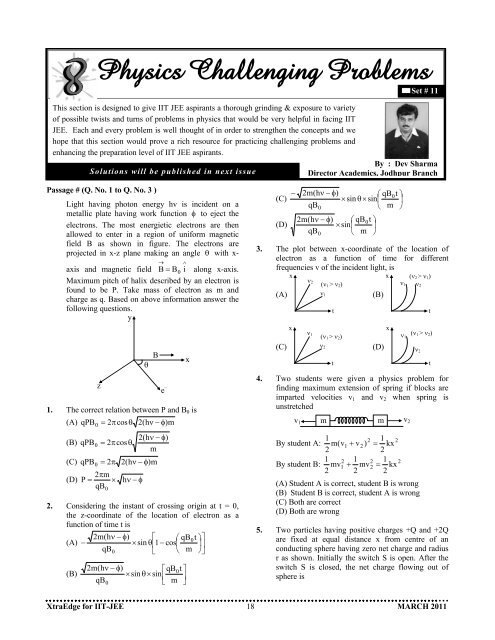March 2011 - Career Point
March 2011 - Career Point
March 2011 - Career Point
Create successful ePaper yourself
Turn your PDF publications into a flip-book with our unique Google optimized e-Paper software.
Physics Challenging Problems<br />
Set # 11<br />
This section is designed to give IIT JEE aspirants a thorough grinding & exposure to variety<br />
of possible twists and turns of problems in physics that would be very helpful in facing IIT<br />
JEE. Each and every problem is well thought of in order to strengthen the concepts and we<br />
hope that this section would prove a rich resource for practicing challenging problems and<br />
enhancing the preparation level of IIT JEE aspirants.<br />
By : Dev Sharma<br />
Solutions will be published in next issue<br />
Director Academics, Jodhpur Branch<br />
Passage # (Q. No. 1 to Q. No. 3 )<br />
Light having photon energy hv is incident on a<br />
metallic plate having work function φ to eject the<br />
electrons. The most energietic electrons are then<br />
allowed to enter in a region of uniform magnetic<br />
field B as shown in figure. The electrons are<br />
projected in x-z plane making an angle θ with x-<br />
→<br />
=<br />
axis and magnetic field B B 0 i along x-axis.<br />
Maximum pitch of halix described by an electron is<br />
found to be P. Take mass of electron as m and<br />
charge as q. Based on above information answer the<br />
following questions.<br />
y<br />
z<br />
1. The correct relation between P and B 0 is<br />
(A) qPB 0 = 2πcosθ<br />
2(hν − φ)<br />
m<br />
(B) qPB 0 = 2πcosθ<br />
2(hν − φ)<br />
m<br />
(C) qPB 0 = 2π<br />
2(hν − φ)<br />
m<br />
2πm<br />
(D) P = ×<br />
qB<br />
hν − φ<br />
0<br />
2. Considering the instant of crossing origin at t = 0,<br />
the z-coordinate of the location of electron as a<br />
function of time t is<br />
2m(hν − φ)<br />
⎡ ⎛ qB0t<br />
⎞⎤<br />
(A) −<br />
× sin θ⎢1<br />
− cos⎜<br />
⎟⎥ qB0<br />
⎣ ⎝ m ⎠ ⎦<br />
(B)<br />
θ<br />
B<br />
e –<br />
m(hν − φ)<br />
⎡qB<br />
t ⎤<br />
× sin θ× sin<br />
qB<br />
⎢ ⎥<br />
⎣ m ⎦<br />
2<br />
0<br />
0<br />
∧<br />
x<br />
(C)<br />
(D)<br />
−<br />
2<br />
0<br />
m(hν − φ)<br />
⎛ qB t ⎞<br />
× sin θ× sin⎜<br />
⎟<br />
qB<br />
⎝ m ⎠<br />
0<br />
m(hν − φ)<br />
⎛ qB t ⎞<br />
× sin⎜<br />
⎟<br />
qB ⎝ m ⎠<br />
2 0<br />
0<br />
3. The plot between x-coordinate of the location of<br />
electron as a function of time for different<br />
frequencies v of the incident light, is<br />
(A)<br />
(C)<br />
x<br />
x<br />
ν 2<br />
(ν 1 > ν 2)<br />
ν 1<br />
ν 1<br />
(ν 1 > ν 2)<br />
ν 2<br />
t<br />
t<br />
(B)<br />
(D)<br />
x<br />
x<br />
(ν 2 > ν 1)<br />
ν 1 ν 2<br />
ν 2<br />
t<br />
ν 1<br />
(ν 1 > ν 2)<br />
4. Two students were given a physics problem for<br />
finding maximum extension of spring if blocks are<br />
imparted velocities v 1 and v 2 when spring is<br />
unstretched<br />
v 1<br />
m m v 2<br />
1<br />
2 1 2<br />
By student A: m(v1 + v2<br />
) = kx<br />
2<br />
2<br />
1 2 1 2 1 2<br />
By student B: mv1 + mv2<br />
= kx<br />
2 2 2<br />
(A) Student A is correct, student B is wrong<br />
(B) Student B is correct, student A is wrong<br />
(C) Both are correct<br />
(D) Both are wrong<br />
5. Two particles having positive charges +Q and +2Q<br />
are fixed at equal distance x from centre of an<br />
conducting sphere having zero net charge and radius<br />
r as shown. Initially the switch S is open. After the<br />
switch S is closed, the net charge flowing out of<br />
sphere is<br />
t<br />
XtraEdge for IIT-JEE 18 MARCH <strong>2011</strong>

















